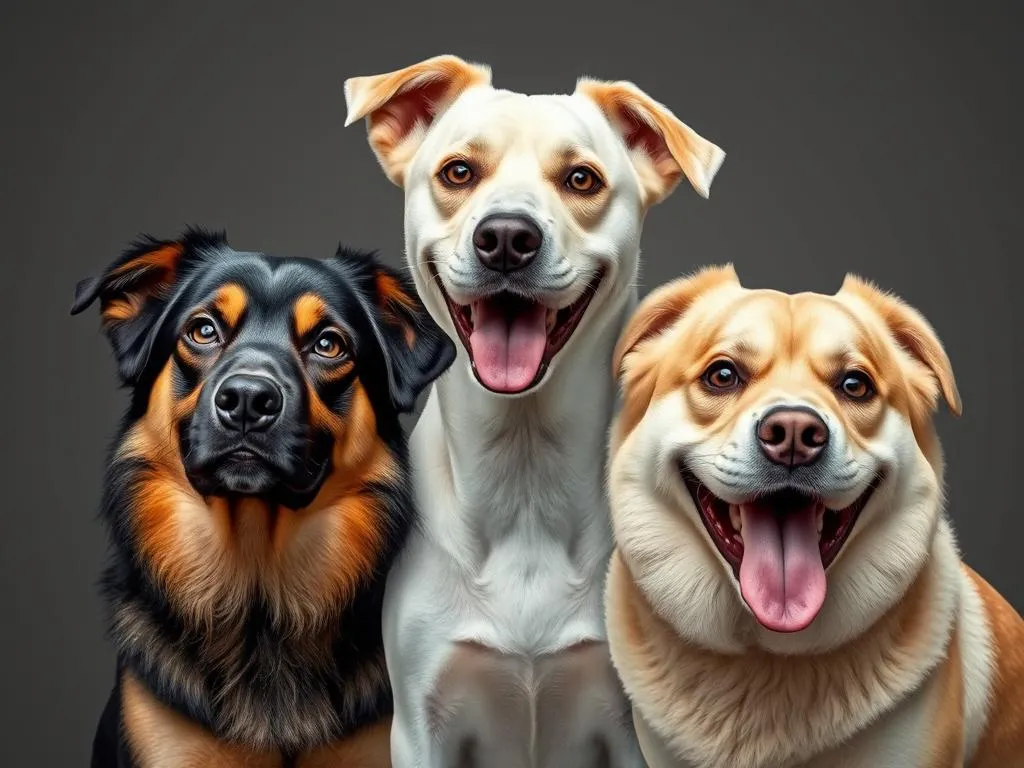
Introduction
Designer dog breeds have become increasingly popular among dog lovers in recent years, captivating the hearts of many with their unique appearances and charming temperaments. But what exactly are designer dog breeds? Unlike purebred dogs, which belong to a specific breed with established standards, designer breeds are the result of intentional crossbreeding between two distinct purebred dogs. This practice aims to combine desirable traits from both parent breeds, leading to an array of fascinating and often unpredictable characteristics.
The surge in popularity of designer dog breeds can be attributed to several factors. Many prospective dog owners are drawn to their unique looks, which often blend the best features of their parent breeds. Additionally, the temperament of designer breeds can be appealing, as breeders often select parent dogs with friendly and adaptable personalities. This article will provide a comprehensive overview of designer dog breeds, including their origins, popular examples, and important considerations for prospective owners.
The Basics of Designer Dog Breeds
What Are Designer Dog Breeds?
The term designer dog breeds refers to intentionally created crossbreeds that combine two or more established purebred dogs. The goal is to enhance specific traits, such as appearance, temperament, or even health characteristics. These breeds often showcase a blend of physical features and behavioral tendencies, making them distinct from traditional purebred dogs.
Designer breeds have their roots in the late 20th century when breeders began experimenting with crossbreeding to create dogs that possessed the best of both worlds. The term gained traction in the 1980s and 1990s, particularly with the rise of the Labradoodle, a cross between a Labrador Retriever and a Poodle.
How Designer Dog Breeds Are Created
Creating designer dog breeds involves a process known as crossbreeding, where two purebred dogs are mated to produce offspring. This practice allows breeders to combine desirable traits from both breeds, such as hypoallergenic coats from Poodles or friendly dispositions from Golden Retrievers.
Responsible breeding is crucial in this process. It involves selecting parent breeds that not only complement each other physically but also share compatible temperaments. Ethical breeders conduct health screenings and genetic testing to minimize the risk of hereditary health issues, ensuring that the resulting puppies are healthy and well-adjusted.
Differences Between Designer and Purebred Dogs
The distinction between designer and purebred dogs lies in several key areas:
-
Appearance: Designer breeds often exhibit a mix of physical traits inherited from both parent breeds, resulting in a unique appearance. Purebreds, on the other hand, conform to specific breed standards outlined by kennel clubs.
-
Health: While purebred dogs may be prone to breed-specific health issues due to a limited gene pool, designer breeds can benefit from hybrid vigor, which may lead to fewer genetic health problems. However, they can still inherit health issues from either parent breed.
-
Temperament: Designer dogs may inherit a combination of personality traits from their parents, leading to varied temperaments. Purebred dogs usually have predictable temperaments based on breed standards.
Both types of dogs have their advantages and disadvantages, and the choice between a designer breed and a purebred dog ultimately depends on the owner’s preferences, lifestyle, and commitment to responsible pet ownership.
Popular Designer Dog Breeds
Overview of Popular Breeds
The world of designer dog breeds is diverse, with many options available for potential dog owners. Here are some of the most popular designer breeds, each with unique characteristics and traits:
-
Labradoodle: A mix of Labrador Retriever and Poodle, known for their friendly nature and hypoallergenic coat.
-
Goldendoodle: A cross between a Golden Retriever and a Poodle, celebrated for their intelligence and loving disposition.
-
Cockapoo: A blend of Cocker Spaniel and Poodle, recognized for their playful attitude and adaptability.
-
Maltipoo: A mix of Maltese and Poodle, loved for their small size and affectionate nature.
-
Pomsky: A cross between a Pomeranian and a Siberian Husky, known for their striking appearance and energetic personality.
Detailed Profiles of Top Designer Breeds
Labradoodle
The Labradoodle originated in Australia in the late 1980s, initially bred as a hypoallergenic service dog. This breed combines the friendly and outgoing nature of the Labrador Retriever with the intelligence and low-shedding coat of the Poodle. Labradoodles are known for their versatility, making them excellent family pets, therapy dogs, and even working dogs. They require regular exercise and grooming but are generally easy to train and sociable, making them ideal for families or individuals who enjoy an active lifestyle.
Goldendoodle
The Goldendoodle is a popular designer breed that combines the affectionate Golden Retriever with the smart and hypoallergenic Poodle. First bred in the late 1990s, Goldendoodles are known for their friendly and gentle temperament, making them great companions for families, seniors, and singles alike. They come in various sizes, depending on whether they are crossed with a standard, miniature, or toy Poodle. Goldendoodles need regular exercise and grooming to maintain their lively spirit and beautiful coat.
Cockapoo
The Cockapoo is a delightful mix between the Cocker Spaniel and the Poodle, known for their playful demeanor and unwavering affection towards their owners. This breed emerged in the 1960s and quickly gained popularity due to their charming personality and adaptability. Cockapoos are intelligent and eager to please, making them relatively easy to train. Their coat can vary in texture, requiring regular grooming to keep it in good shape. They are excellent family pets and thrive in homes with children and other pets.
Maltipoo
The Maltipoo, a cross between the Maltese and the Poodle, is a small yet spirited breed that has captured the hearts of many dog lovers. Known for their playful and affectionate nature, Maltipoos are ideal for apartment living due to their small size. They are intelligent and eager to learn, making training a rewarding experience. Regular grooming is essential to maintain their soft, fluffy coat. Maltipoos are highly social and thrive on companionship, making them perfect lap dogs for those seeking a close bond with their pet.
Pomsky
The Pomsky is a relatively new designer breed that has gained popularity for its striking appearance, combining the adorable features of a Pomeranian with the striking looks of a Siberian Husky. First bred in the early 2010s, Pomskies are energetic and playful, requiring ample exercise and mental stimulation. They can be independent and stubborn at times, so consistent training and socialization are necessary. Pomskies are highly social and thrive in active households where they can engage with their owners and other pets.
Lesser-Known Designer Breeds
Beyond the popular choices, there are several lesser-known designer breeds worth exploring. These unique combinations often showcase fascinating traits and characteristics:
-
Schnoodle: A cross between a Schnauzer and a Poodle, Schnoodles are known for their intelligence and loyalty. They make excellent family pets and are highly trainable.
-
Doxiepoo: This delightful mix of Dachshund and Poodle boasts a charming personality and a low-shedding coat. Doxiepoos are playful and affectionate, making them great companions.
-
Cavapoo: A cross between a Cavalier King Charles Spaniel and a Poodle, Cavapoos are friendly and gentle, often becoming beloved family members.
These lesser-known breeds offer a variety of unique traits that may appeal to those looking for something beyond the mainstream designer dogs.
Considerations Before Getting a Designer Dog
Assessing Your Lifestyle
Before bringing a designer dog breed into your home, it’s essential to assess your lifestyle. Factors such as space, activity level, and time commitment play a significant role in determining the right breed for you. For instance, active breeds like the Goldendoodle or Labradoodle require ample exercise and mental stimulation, while smaller breeds like Maltipoos may thrive in more confined spaces.
Consider your daily routine, work schedule, and whether you have children or other pets. Matching the right breed to your lifestyle ensures a harmonious living environment for both you and your new furry friend.
Health Considerations
While designer dog breeds can benefit from hybrid vigor, they are not immune to health problems. Many designer breeds inherit health issues from their purebred parents, such as hip dysplasia, eye conditions, or skin allergies. It’s crucial to research the specific health concerns associated with the breeds involved in your chosen designer dog.
Prioritize working with responsible breeders who conduct health screenings and genetic testing on their breeding stock. This practice can help identify and reduce the risk of potential health issues in your future pet.
Training and Socialization Needs
Training and socialization are critical components of raising a well-adjusted designer dog. Many designer breeds are intelligent and eager to please, making them relatively easy to train. However, early socialization is vital to ensure they grow up to be well-rounded and confident dogs.
Enroll your puppy in basic obedience classes and expose them to various environments, people, and other dogs. Consistent training and positive reinforcement will help establish good behavior and strengthen the bond between you and your dog.
Caring for Designer Dogs
Nutrition and Diet
Proper nutrition is essential for the health and well-being of your designer dog. Because these breeds can vary significantly in size and energy levels, it’s important to choose a high-quality dog food that meets their specific dietary needs. Look for foods that list meat as the first ingredient and avoid fillers like corn and soy.
Consult with your veterinarian to determine the best diet for your designer breed, taking into account their age, weight, and activity level. Fresh water should always be available, and be mindful of portion sizes to prevent obesity, which can lead to various health issues.
Grooming Requirements
Grooming needs for designer dog breeds can vary widely based on their coat type. Breeds with Poodle heritage, like Labradoodles and Goldendoodles, typically have curly coats that require regular grooming to prevent matting. On the other hand, breeds like Maltipoos may have softer, wavier coats that also need regular brushing.
Establish a grooming routine that includes regular brushing, occasional baths, and professional grooming when necessary. This routine not only keeps your dog looking their best but also provides an opportunity to check for skin issues, parasites, or other health concerns.
Regular Veterinary Care
Routine veterinary care is essential for maintaining your designer dog’s health. Schedule regular check-ups to monitor their overall health and ensure they are up-to-date on vaccinations. Discuss any particular health concerns related to their breed or mix with your veterinarian.
Preventive care, including dental cleanings and parasite prevention, is also crucial. Regular veterinary visits help catch any potential health issues early and ensure your dog lives a long, healthy life.
The Future of Designer Dog Breeds
Trends in Breeding
As the popularity of designer dog breeds continues to rise, new trends in breeding are emerging. Breeders are increasingly focusing on creating breeds that possess specific traits, such as low-shedding coats or unique color patterns. There is also a growing interest in smaller designer breeds, catering to urban dwellers and individuals seeking compact companions.
Expect to see more hybrid breeds in the future, as breeders experiment with new combinations to meet the demands of potential dog owners who value both aesthetics and temperament.
Ethical Considerations
With the rise in popularity of designer dog breeds comes a responsibility to ensure ethical breeding practices. Not all breeders prioritize the well-being of their dogs, leading to concerns about puppy mills and irresponsible breeding. It’s essential to research breeders thoroughly, looking for those who adhere to ethical standards and prioritize the health and socialization of their puppies.
Moreover, consider the importance of adopting dogs from shelters or rescue organizations. Many mixed-breed dogs are in need of loving homes, and choosing adoption over buying can make a significant difference in their lives.
Conclusion
In conclusion, designer dog breeds offer an exciting variety of options for dog lovers seeking unique companions. With their diverse characteristics and appealing temperaments, these breeds can fit into various lifestyles and family dynamics. However, it’s crucial to approach the decision to adopt a designer dog with careful consideration of factors like lifestyle, health, and training needs.
By understanding the intricacies of designer breeds and committing to responsible ownership, you can ensure a fulfilling relationship with your future furry friend. Always remember to do thorough research and choose a reputable source when bringing a new dog into your home. This thoughtful approach will lead to a happier, healthier life for both you and your designer dog.









